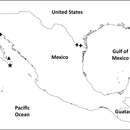en
names in breadcrumbs


The spider family Caponiidae (bright lungless spiders), the members of which are found mainly in the Americas and southern Africa, includes 86 described species (Platnick 2013), with only around eight to ten species recorded from North America north of Mexico.
Caponiids are morphologically unusual in a number of ways. They differ from other spiders in lacking book lungs and having the posterior median spinnerets anteriorly displaced to form a transverse row with the anterior lateral spinnerets. Most species have only two eyes (although the ancestral state for the group is to have eight eyes) and, unlike other spiders showing eye loss, they retain the anterior median eyes.
Caponiids are wandering hunters, typically found on the ground, under rocks, and in leaf litter. Some species are known only from Neotoma woodrat nests. Most of the Nearctic species live in arid deserts or desert scrub (Orthonops and Tarsonops), whereas others (the single species of Calponia, some Orthonops) occur in habitats ranging from oak savanna to closed canopy forests. Caponiids are believed to favor other spiders as food, although at least in the lab their diet is not restricted to spiders.
Calponia harrisonfordi was described (from California, where it is endemic to the central California Coast Ranges) only in 1993 (Platnick 1993). Spiders of this species (which was named in honor of the American film actor Harrison Ford, a generous supporter of the American Museum of Natural History) have eight eyes. Orthonops was revised by Platnick in 1995.
(Ubick 2005; Bradley 2013)